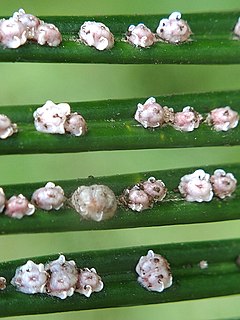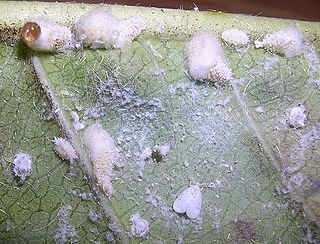Related Research Articles

Mealybugs are insects in the family Pseudococcidae, unarmored scale insects found in moist, warm habitats. Many species are considered pests as they feed on plant juices of greenhouse plants, house plants and subtropical trees and also act as a vector for several plant diseases. Some ants, however live in symbiotic relationships with them.

Scale insects are small insects of the order Hemiptera, suborder Sternorrhyncha. Of dramatically variable appearance and extreme sexual dimorphism, they comprise the superfamily Coccoidea. Adult females typically have soft bodies and no limbs, and are concealed underneath domed scales, extruding quantities of wax for protection. Some species are hermaphroditic, with a combined ovotestis instead of separate ovaries and testes. Males, in the species where they occur, have legs and sometimes wings, and resemble small flies. Scale insects are herbivores, piercing plant tissues with their mouthparts and remaining in one place, feeding on sap. The excess fluid they imbibe is secreted as honeydew on which sooty mold tends to grow. The insects often have a mutualistic relationship with ants, which feed on the honeydew and protect them from predators. There are about 8,000 described species.

The Sternorrhyncha suborder of the Hemiptera contains the aphids, whiteflies, and scale insects, groups which were traditionally included in the order Homoptera. "Sternorrhyncha" refers to the rearward position of the mouthparts relative to the head.
Phyllococcus oahuensis was a species of mealybug in the family Pseudococcidae, and the only species in the genus Phyllococcus. It was endemic to Hawaii.
Paratachardina pseudolobata, the lobate lac scale, is a polyphagous and pestiferous lac scale insect, which damages trees and woody shrubs in Cuba, Florida, the Bahamas and the Australian territory of Christmas Island. It was mistakenly identified as Paratachardina lobata (Chamberlin), an insect native to India and Sri Lanka, but was in 2007 recognized and named as a distinct species based on material from Florida; its native distribution is as yet unknown. The new lac insect was described based on all stages of the female, during the revision of the genus Paratachardina, wherein all its known species were redescribed.

Trophobiosis is a symbiotic association between organisms where food is obtained or provided. The provider of food in the association is referred to as a trophobiont. The name is derived from the Greek τροφή trophē, meaning "nourishment" and -βίωσις -biosis which is short for the English symbiosis.

Acropyga is a genus of small formicine ants. Some species can be indirect pests. A. acutiventris, which is found from India to Australia, tends subterranean, root-feeding mealybugs of the species Xenococcus annandalei. Living, gravid females are carried in the jaws of A. acutiventris queens during their nuptial flight, to establish the symbiotic association in founding colonies. Other Acropyga species have relationships with different species of mealybugs, and it could be a trait common to the whole genus.

Pseudococcus viburni is a close relative of the grape mealybug and a pest of the vineyards of New Zealand, the Central Coast of California, and the tea gardens of northern Iran. Unlike the grape mealybug, the obscure mealybug is not native to California, having most likely been introduced to the region from either Australia or South America in the latter part of the 19th century.

Diaspididae is the largest family of scale insects with over 2650 described species in around 400 genera. As with all scale insects, the female produces a waxy protective scale beneath which it feeds on its host plant. Diaspidid scales are far more substantial than those of most other families, incorporating the exuviae from the first two nymphal instars and sometimes faecal matter and fragments of the host plant. These can be complex and extremely waterproof structures rather resembling a suit of armor. For this reason these insects are commonly referred to as armored scale insects. As it is so robust and firmly attached to the host plant, the scale often persists long after the insect has died.

Electromyrmococcus is an extinct genus of mealybug in the Pseudococcidae subfamily Rhizoecinae. The genus currently contains three species, all from the early Miocene, Burdigalian stage, Dominican amber deposits on the island of Hispaniola.
Micrococcidae is a family of scale insects commonly known as the Mediterranean scales. There are two genera and eight species. Members of this family are found in Cyprus, Italy and other Mediterranean countries including Egypt, France, Greece, Israel, Lebanon, Libya, Syria and Turkey.
Phenacoleachiidae is a family of scale insects commonly known as the phenacoleachiids. They are found only in the South Island of New Zealand, and on certain offshore islands. There are two species in a single genus.
Putoidae is a family of scale insects commonly known as giant mealybugs or putoids. There is probably a single genus, Puto, containing about sixty species. The genus name Macrocerococcus has also been used but it is now considered to be a synonym of Puto. The genus Puto was formerly classified as a member of the Pseudococcidae; however, it so significantly differed from the rest of the Pseudococcidae that it was accorded its own family Putoidae.

Paracoccus marginatus, commonly known as the papaya mealybug, is a small sap-sucking insect in the mealybug family, Pseudococcidae. It is found on a number of different hosts, including economically important tropical fruit trees and various ornamental plants.
Phenacoccus manihoti is a scale insect species.

Planococcus citri, commonly known as the citrus mealybug, is a species of mealybugs native to Asia. It has been introduced to the rest of the world, including Europe, the Americas, and Oceania, as an agricultural pest. It is associated with citrus, but it attacks a wide range of crop plants, ornamental plants, and wild flora.
John Stuart Noyes is a Welsh entomologist.
Trabutina mannipara, or mana scale, is a species of mealybug found in the Middle East and southern Europe. It is the most well-known of the five species in the genus Trabutina, of which it is the type species, due to its association with the biblical story of manna. T. mannipara feeds parasitically on tamarisk trees, and excretes a sweet substance which is sometimes collected for human consumption. Obsolete terms for it include Coccus manniparus and Trabutina palestina. This species can be found in the Sinai and Iraq.
"Blue-green" mealybugs are a group of related mealybug genera whose insides, during adulthood, are usually of the color which gives them their collective name. Alternately, this group may be referred to as blue-black mealybugs. It includes the genera Amonostherium, Australicoccus, Melanococus, and Nipaecoccus.
Geococcus coffeae is a species in the mealybug family, Pseudococcidae, commonly known as the coffee root mealybug, or brown scale. It lives underground where it inserts its mouthparts into roots and sucks the sap.
References
- ↑ Howard Lester McKenzie (1967). Mealybugs of California: With Taxonomy, Biology, and Control of North American Species (Homoptera, Coccoidea, Pseudococcidae). University of California Press. p. 52. GGKEY:QPJX206YQYC.
- ↑ Douglas John Williams (1985). Australian mealybugs. British Museum (Natural History). pp. 54, 335. ISBN 978-0-565-00953-3.
- 1 2 Danzig, Evelyna M.; Miller, Douglass R. (1996). "A Systematic Revision of the Mealybug Genus Trabutina (Homoptera: Coccoidea: Pseudococcidae)" (PDF). Israel Journal of Entomology. 30: 7–46.
- ↑ Williams, D.J.; Gullan, P. J. (2010). "Family-group names proposed in the family Pseudococcidae (Hemiptera: Sternorrhyncha: Coccoidea)" (PDF). Zootaxa (2400): 66–68.
- ↑ Jun Mitsuhashi (19 December 2016). Edible Insects of the World. CRC Press. p. 78. ISBN 978-1-315-35088-2.
- ↑ Degen, A. A.; Gersani, M. (1989). "Environmental effects on activity and honeydew collection by the weaver ant Polyrhachis simplex (Hymenoptera: Formicidae) when attending the mealybug Trabutina sp. (Homoptera: Pseudococcidae)". Journal of Zoology. 218 (3): 421–432. doi:10.1111/j.1469-7998.1989.tb02554.x.
| | This article related to members of the insect superfamily Coccoidea is a stub. You can help Wikipedia by expanding it. |